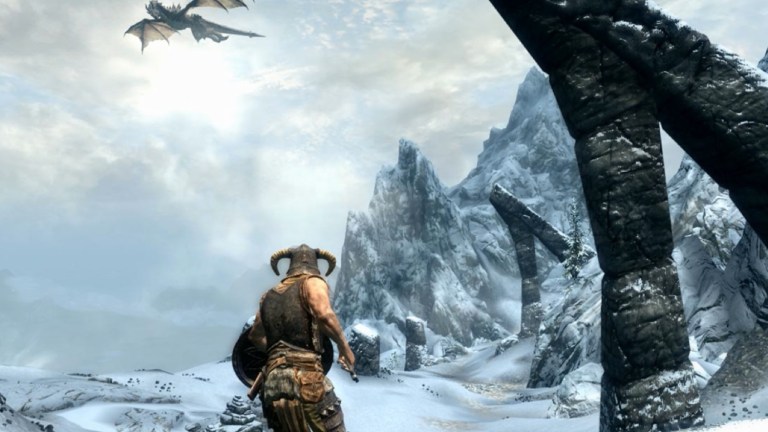Skyrim Designer Reveals the Biggest Problems With Modern Open-World Games
Former and current Elder Scrolls team members share their thoughts on the state of modern open-world games, how we got to this point, and where the genre is heading.

In an extensive and excellent interview with Rock, Paper, Shotgun, former Skyrim and Fallout designer Nate Purkeypile shared his thoughts on some of the biggest problems facing modern open-world games. Chief among them was the increasingly popular decision to design such games around clearly outlined objectives and activities.
“I think a lot of it has to do with the way some open-world games are designed, where it is very much that checklist,” Purkeypile says. “These games can be a lot of fun, and I’ve had fun with them, too, but I have that same fatigue…That feeling of not really knowing what’s over there and feeling surprised – you don’t really feel like you’re exploring the world, if you’re not actually surprised.”
Why have more and more modern open-world games utilized that format? Purkeypile partially attributes the change to an increase in the production size of such titles.
“When you have literally thousands of people working on the game, sometimes you need to be able to have these bite-sized portions of ‘do this, go there’,” Purkeypile observes. “It’s very hard to run things at that scale without all those checks and balances and stuff.”
Purkeypile elaborates on that point by stating that when there were about 100 people working on Skyrim, the team could “take something and make it your own.” By comparison, he notes that when you have “500-ish people across four studios,” it’s harder to allow for such individual contributions and trust in the power of the collective team voice in quite the same way. He mentioned that there are notable examples of “individual storytelling” in Starfield, but that it’s just “harder at that scale” to give each area of the in-game world the distinctive flavor and personality required to encourage and reward more organic exploration.
That’s hardly the only factor that has led to such a seismic shift in design philosophy, though. As Elder Scrolls Online director Matt Firor notes in that interview, that shift should also be attributed to changes in consumer trends.
“[We now] have to support both those kind of hardcore players – I’m saying hardcore, that term is loaded – but the people that really want to take the time and live everything and make it difficult, and then the wider audience that really just has 20 minutes to burn,” Firor notes.
That need to appeal to such a wide variety of players has led to the common use of a kind of middle-ground that allows players to engage with such games at their own pace.
“It’s make a space and then just populate it with things to do, and the players can do it in any order. And sometimes it’s a little chaotic,” Firor adds. “And sometimes you can’t figure out what the players are going to figure out, because they’re smarter than you. But that’s what the world is like too. And it’s so much fun, just to create space and let players into it, and then see what they do.”
Firor contrasts that design style with that of Morrowind: a kind of patron saint title for the hardcore open-world RPG experience. While Firor also has a lot of love for that game, he says that it would simply be difficult to give players quite that kind of freedom without also offering a greater sense of direction to individual points of interest.
“If you play that right now – there is no compass, no map, literally the quests are like ‘go to the third tree on the right and walk 50 paces west’,” Firor says of Morrowind. “And if you did that now, no one would play it. Very few people would play it…Now [that there are] so many other options for players, you really want to make sure that it’s engaging and fun, and wandering around a field trying to gauge 50 steps from a tree is not part of that anymore. Which is kind of sad, because I’m old school.”
That ultimately feels like the heart of the issue. The concessions made to accommodate such a quickly growing audience for open-world games (specifically, open-world RPGs) have been understandable, brilliant in many ways, and have often led to worthwhile titles we otherwise wouldn’t have gotten to enjoy. Yet, those concessions often take us further from games like Morrowind. If you enjoy those kinds of games and the ideas they represent, they are simply becoming increasingly harder to find on quite the same production scale.
Look close enough, though, and you’ll already see the winds of change blowing. Some of the most successful open-ended games of the last few years (Elden Ring, Tears of the Kingdom, and Baldur’s Gate 3) were made by slightly smaller, more creative vision-focused teams that ultimately emphasized more personality-driven worlds that organically encouraged player experimentation with fewer signposts. It’s not quite a full-on revolution in the industry, but there certainly appears to be a market for such titles that went woefully ignored for quite some time.
Yet, maybe it does all come back to Skyrim. These days, Skyrim practically feels like Morrowind compared to those checklist titles. Perhaps there is more room in that aforementioned middle ground that hasn’t been thoroughly explored quite yet. Crucially, if GTA 6 utilizes the more exploration-based minimalist elements seen in Red Dead Redemption 2, we could see a more seismic shift in open-world design that brings us a bit closer to that era gone by.

